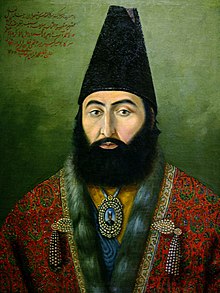Mirza Taghi Khan | |
|---|---|
میرزا تقیخان فراهانی | |
 | |
| Prime Minister of Iran | |
| In office 12 May 1848 – 13 November 1851 | |
| Monarch | Naser al-Din Shah |
| Preceded by | Hajj Mirza Aghasi |
| Succeeded by | Mirza Aqa Khan-e Nuri |
| Personal details | |
| Born | 9 January 1807[citation needed] Hazaveh, Arak, Persia |
| Died | 10 January 1852 (aged 45) Fin Garden, Kashan, Persia |
| Manner of death | Assassination |
| Political party | Independent |
| Spouses |
|
| Children | 5, including Taj ol-Molouk and Hamdam ol-Molouk |
| Parent(s) | Karbalayi Ghorban Ashpazbashi Fatemeh Khanom |
Mirza Taghi Khan-e Farahani (Persian: میرزا تقیخان فراهانی), better known as Amir Kabir (Persian: امیرکبیر; 9 January 1807[citation needed] – 10 January 1852),[a] was chief minister to Naser al-Din Shah Qajar (Shah of Persia) for the first three years of his reign. He is widely considered to be "Iran's first reformer", a modernizer who was "unjustly struck down" as he attempted to bring "gradual reform" to Iran.[1] Amir Kabir founded the first centre for higher education in Iran and the second Persian-language newspaper in the country. He prohibited bribery, torture of defendants and prisoners, and structured Iranian tax and financial system. As the prime minister, he also ordered suppression of Babism and the execution of the founder of the movement, the Báb. In the last years of his life he was exiled to Fin Garden in Kashan and was murdered by command of Naser al-Din Shah Qajar on 10 January 1852.[2]
Cite error: There are <ref group=lower-alpha> tags or {{efn}} templates on this page, but the references will not show without a {{reflist|group=lower-alpha}} template or {{notelist}} template (see the help page).
- ^ Molavi, Afshin, The Soul of Iran, Norton, 2005, p.195,197
- ^ Smith, Peter (2000). "Amir Kabir, Mirza Taqi Khan". A concise encyclopedia of the Bahá'í Faith. Oxford: Oneworld Publications. pp. 38. ISBN 978-1-85168-184-6.